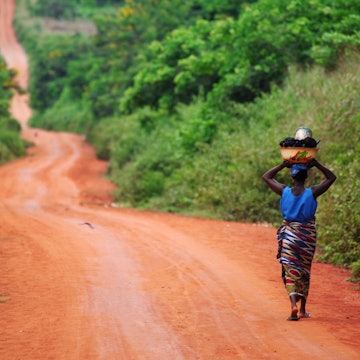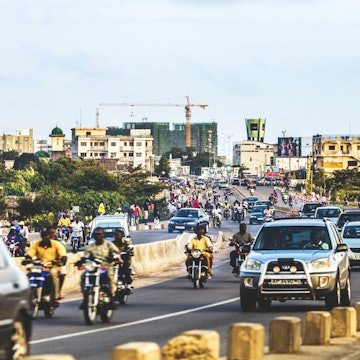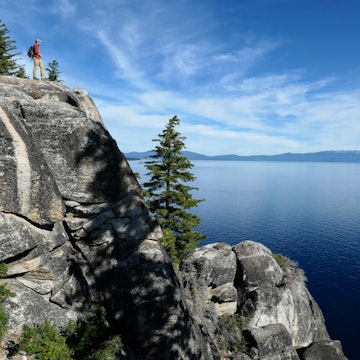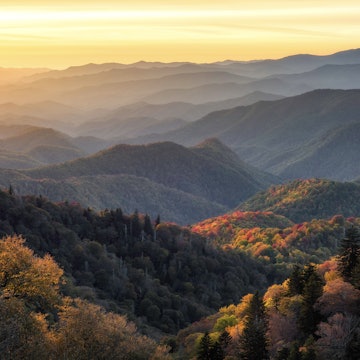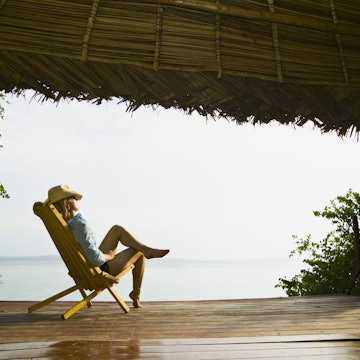

Road trips are the best way to see Benin © peeterv / Getty Images
Underrated and underexplored, the small slither of West Africa that makes up Benin is best covered by road.
Neighboring Nigeria to the east, Togo and Burkina Faso to the west, and Niger to the north, Benin has as much to offer as each of them. From experiencing Vodou culture in Ouidah and learning about the Dahomey Kingdom in Abomey to visiting the revered watermen of the “Venice of Africa,” surprises and spectacular locations keep coming.
Here we've picked four road trips that take in the highlights of Benin, including the beaches of Grand Popo, the capital Porto Novo and the hustle and bustle of Cotonou. Buckle up.

1. Vodou adventures
Benin's most extraordinary drive
Cotonou–Ouidah; 38 km (23.5 miles); 1 hour 30 minutes
Lined by impeccable ginger-colored beaches and filled with abundant markets selling everything from plastic sandals to goats, Cotonou is the ideal place to acquaint yourself with Benin. But to get a deeper understanding of its Vodou culture, take the RNIE1 road inland and expect the unexpected. Vodou – also spelled Vodun – is a religion that draws together medicine, philosophy and justice through the idea that everything is spirit. So on this route, you could encounter people carrying animal carcasses, or Vodou priests performing rituals. Seeing energetic dances isn’t uncommon. Vodou started in Ouidah but spread to the Americas and Europe during the trans-Atlantic trade of enslaved Africans.
If you take this road trip at the beginning of the year, you up your chances of encountering Vodou rituals as locals prepare for Fête du Vodun on January 10, a countrywide celebration of the culture that focuses on Ouidah. Stop in Pahou to take in the busy, often dusty market. It’s a good spot to stretch your legs and grab refreshments – fresh pineapples, peanuts, cashews, bottled water and street food such as àkàrà (a fried black-eyed-pea cake) – and take in the cacophony of hollering stallholders, honking motorbikes and hearty bartering.
From there, the new two-lane Pahou–Ouidah carriageway significantly speeds up your journey. Pull in at the 4-hectare Sacred Forest on the outskirts of Ouidah to find wooden statues of Vodou deities – often anthropomorphized characters – hidden amongst the iroko trees and medicinal plants. Once you arrive in the town itself, head to the Ouidah Museum of History to learn more about Vodou.

2. The Lake Nokoué loop
Benin's most scenic road trip
Porto Novo– Ganvié; 37 km (23 miles), 2 hours
Benin's most striking road trip loops around the stunning Lake Nokoué from Porto Novo to Ganvié via the RNIE1 and RNIE2. These are dry and dusty dirt roads with plenty of potholes, so drive with caution. Home to the white-crested tiger heron and the African openbill, you'll get to see the sparkling, 16,000-hectare lake from several angles during this drive before ending in Ganvié, the “Venice of Africa.”
The stilt village, the largest of its kind on the African continent, is popular with tourists. Start off early to give yourself a full day at Ganvié so you can interact with the locals and learn about their culture. Tour guides also offer boat hire on the lake.
Planning tip: There are no real stops on the way to Lake Nokoué, so make sure you fill up with gas in Porto Novo before you start.

3. The king's route
Best road trip for first-timers
Grand Popo–Abomey; 147 km (91 miles), 3 hours
Heading north from the sandy beaches of Grand Popo, Benin begins to look like a completely different country. From the car you will see fields of yam and maize, grazing animals, and women and girls carrying large containers of water on their heads as they walk down the side of the road. Leaving the hot sandy beaches and the salty smell of the ocean behind, the temperatures become cooler as luscious forests with thick green canopies start to cover the landscape.
Head along RNIE1 and then take RNIE4 to Abomey, the capital of the ancient West African Kingdom of Dahomey, which ruled from 1625 to 1894. The RNIE4 is the longest dirt road you will encounter. It has a lot of potholes and is best avoided during the rainy season (May–November). With few stops, tank up adequately.
One of Benin's most culturally significant destinations, the winding lanes of Abomey are home to numerous temples and palaces, showing the country's heritage before slavery and colonialism engulfed the region. Make sure you visit the Musée Historique d'Abomey and the Epic of the Amazons. You’ll learn about the customs and traditions of the Dahomey Kingdom of the north in the tour and you’ll get to see their ancient palaces.
4. A capital-to-capital cruise
Best road trip to compare the ancient with the modern
Abomey–Porto Novo; 131 km (81 miles), 3 hours 30 minutes
Traveling north to south from the ancient capital of the Dahomey Kingdom to Benin's modern-day counterpart is a whirring cacophony of green landscapes, interspersed with houses, schools, churches and gatherings of people. Arriving in Porto Novo, head to historical landmarks including the Notre-Dame Cathedral, Grande Musee de Porto Novo and Jardin des Plantes et de la Nature. The Afro-Brazilian architecture of these sights helped influence the region during the transatlantic trade of enslaved Africans that lasted more than 400 years.
This route begins as a dirt road and becomes a tarmac road halfway through. There is a significant number of potholes but it’s easier to maneuver on this road than some of the other country tracks. There are also plenty of petrol stations along the way.
Tips for driving in Benin
Don't rely on Google Maps to get around Benin as the service isn’t always accurate.
It is possible to rent a car in Benin but hiring a local driver is often a better choice as they know the roads well.
Aim to take road trips during the dry season (December–February). Road conditions can be challenging in the wet season (May–November) because of flooding, hidden potholes and long distances without any roadside amenities.








